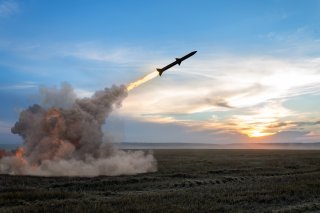Russia Is Running Low on Advanced Munitions to Use in Ukraine
Under the weight of international sanctions and the general production issues of the Russian defense and aerospace industries, Moscow can only produce a fraction of the advanced weapon systems needed to wage a modern war every month.
The Russian military has a serious issue with advanced munitions.
The demands of the war, coupled with chronic production issues, have left the Russian military without enough advanced munitions to sustain the necessary rate of fire for a large-scale conflict like the one in Ukraine.
Advanced Munitions Issues
Earlier in December, the Russian military launched a large-scale, combined arms offensive. To support its ground forces, the Russian military used advanced long-range munitions. However, in a single instance, Moscow used munitions that took months to produce.
“Overnight 12-13 December Russia conducted a large-scale multi-axis attack into Ukraine. As with the attacks that occurred in November and prior, it involved Russian Long Range Aviation assets and Russian fixed wing Tactical Aviation assets launching multiple types of air launched cruise-missile and air launched ballistic missile systems,” the British Military Intelligence assessed over the weekend.
“The air assets were supported by SAGARIS Land Attack Cruise Missiles launched by Black Sea Fleet assets, and One-Way Attack Uncrewed Aerial Systems (OWA UAS) were used from multiple launch sites,” the British Military Intelligence added.
All in all, the Russian military supported its large-scale offensive with approximately 180 suicide drones and ninety ballistic and cruise missiles.
The important thing to highlight is that the Russian military can afford to launch such attacks only every few months. Under the weight of international sanctions and the general production issues of the Russian defense and aerospace industries, Moscow can only produce a fraction of the advanced weapon systems needed to wage a modern war every month. As such, the Russian military has to time its large-scale offensives to match the arrhythmic Russian military production capacity.
“Since August 2024, it is highly likely Russia has chosen to take time to build stocks between strikes and then launch in larger, less frequent strike waves, rather than the more frequent smaller attack conducted earlier in the year,” the British Military Intelligence assessed.
The Russian military is so short on key components, such as semiconductors, that it has to scavenge consumer products like refrigerators, microwaves, and dishwashing machines for chips to put in missiles. Also, the Russian military has been using specialized munitions for the wrong missions—for example, anti-ship missiles against ground targets. The Kremlin is working with other countries to bolster its stocks of munitions. Iran, for example, has provided thousands of suicide drones and hundreds of missiles to Russia.
“The composition and target set of the 12-13 December attack was similar to previous attacks, focusing on Ukrainian Critical National Infrastructure and industry, whilst also attempting to suppress Ukrainian Air Defense and airfields by saturating them with OWA UAS,” the British Military Intelligence stated.
Importantly, the Russian military remains capable of launching missile and drone attacks against Ukrainian urban centers and critical infrastructure at a moment’s notice, even if such attacks can’t always be large-scale.
“However, Russia retains the ability and the stocks to allow such assets to be employed in smaller numbers, as a punitive measure, with little or no warning,” the British Military Intelligence concluded.
Stavros Atlamazoglou is a seasoned defense journalist specializing in special operations and a Hellenic Army veteran (national service with the 575th Marine Battalion and Army HQ). He holds a BA from Johns Hopkins University and an MA from Johns Hopkins’ School of Advanced International Studies (SAIS). His work has been featured in Business Insider, Sandboxx, and SOFREP.
Image: Shutterstock.

